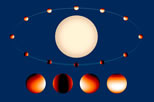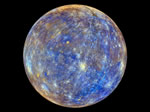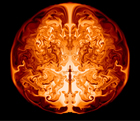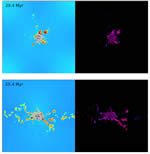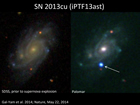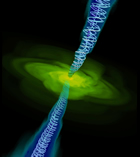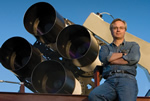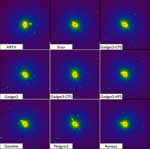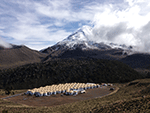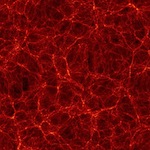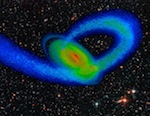Word doc
PDF (formatted and ready to go as a single newsletter page)
A Black Hole is Born—and Caught in the Act!
The moment photons began arriving at Earth shortly after midnight New Mexico time on Saturday, April 27, 2013, from the spectacular suicide of a massive star and resultant birth of a black hole, cameras began clicking on telescopes both on the ground and in space. Exultant astronomers worldwide captured data at visible, X-ray, gamma-ray, and radio wavelengths from telescopes both on the ground and in space.
Three independent RAPTOR (Rapid Telescopes for Optical Response) full-sky monitoring telescopes—two in New Mexico and one in Hawaii—caught an optical flash that within seconds brightened up to a peak of 7th magnitude (yes, bright enough to have been seen in an amateur astronomer’s telescope had it been pointed north of the triangle in the constellation Leo), and then faded over the next minute and a half to below 10th magnitude. Simultaneously, the Gamma Ray Burst Monitor (GBM) on the Fermi satellite, the Burst Alert Telescope (BAT) on the Swift satellite, and a veritable armada of other instruments caught the cataclysmic stellar explosion in the act, as did radio telescopes around the world.
Even more unusual, the explosion left an afterglow across the electromagnetic spectrum that persisted for weeks following the initial burst. Now, a host of papers in the January 3, 2014, issue of Science magazine reveal in detail just what happened.
‘The burst of the century’
“This was the burst of the century!” exclaimed James A. Wren, an engineer at Los Alamos National Laboratory and co-author of one of the papers. Indeed, GRB 130427A (as it is now called) was the most powerful gamma-ray burst and the second-brightest optical flash measured in 18 years.
The supernova detonated in a tiny, inconspicuous galaxy with no name some 3.8 billion light-years away. Partly it was so bright because that point of origin is actually five times closer to the Milky Way than typical long-duration gamma-ray bursts monitored by Swift, which are from galaxies that are now more than 17 billion light years away from us (thanks to the faster-than-light expansion of the distant universe according to General Relativity). But partly it was so bright because of the explosion’s intrinsic power: it released 1054 ergs of energy in all directions, making GRB 130427A one of the most powerful gamma-ray bursts ever detected.
The comparatively long life of the gamma-ray burst points to the death of a star perhaps 25 to 30 times more massive than the Sun, whose internal core of iron abruptly collapsed in on itself, creating a highly magnetized neutron star or black hole. Somehow, this fast-spinning, compact object launches a powerful jet of particles traveling at nearly the speed of light along its axis of rotation. Internal shockwaves within this relativistic jet creates the initial burst of what is called “prompt” emission spanning from optical to gamma-ray wavelengths; in the case of GRB 130427A, the prompt emission lasted about 5 minutes.
Then, when the jet starts colliding with the surrounding outer layers of the star and interstellar medium, external shock waves give rise to a longer-lasting afterglow emission. The afterglow of GRB 130427A—which spanned from radio waves to gamma rays—persisted for weeks.
‘A Rosetta-Stone event’
What made this burst different from most others is that the sheer power of the explosion so comparatively nearby allowed astronomers to follow the star’s decline in brightness over many wavelengths for weeks, giving them a glimpse into details of the explosion’s physics usually too faint to observe.
“It is the link between the optical phenomenon and the gamma rays we haven’t seen before,” observed another Los Alamos co-author Przemek Wozniak.
“This was a Rosetta-Stone event that illuminates so many things—literally,” affirmed lead author, Los Alamos astrophysicist W. Thomas Vestrand. “These are data that astrophysicists will be looking at for a long time to come.”
–Trudy E. Bell, M.A.
Further reading:
Link to the paper “The Bright Optical flash and Afterglow from the Gamma-Ray Burst GRB 130427A” by Vestrand et al. published in Science is at http://arxiv.org/abs/1311.5489 . A LANL press release “Black hole birth caught by cosmic voyeurs,” is at
https://www.lanl.gov/newsroom/news-releases/2013/November/11.21-black-hole-birth.php.
The University of California High-Performance AstroComputing Center (UC-HIPACC), based at the University of California, Santa Cruz, is a consortium of nine University of California campuses and three Department of Energy laboratories (Lawrence Berkeley Laboratory, Lawrence Livermore Laboratory, and Los Alamos National Laboratory). UC-HiPACC fosters collaborations among researchers at the various sites by offering travel and other grants, co-sponsoring conferences, and drawing attention to the world-class resources for computational astronomy within the University of California system. More information appears at http://hipacc.ucsc.edu .
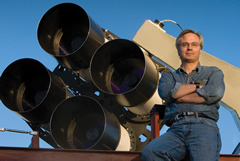
Credit: Los Alamos National Laboratory
